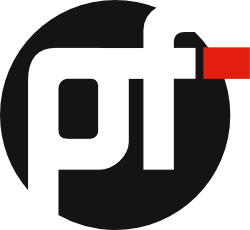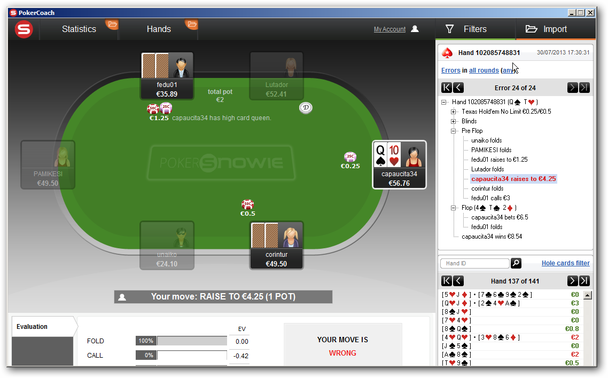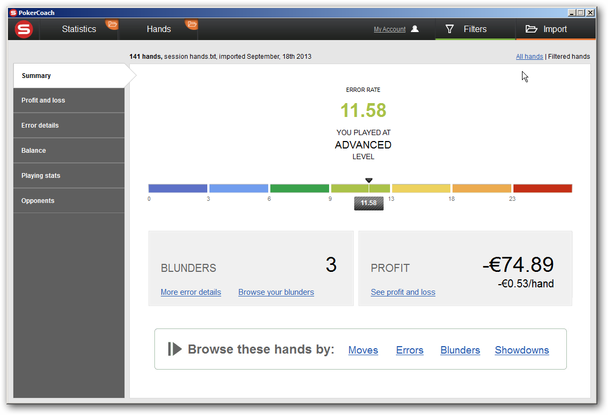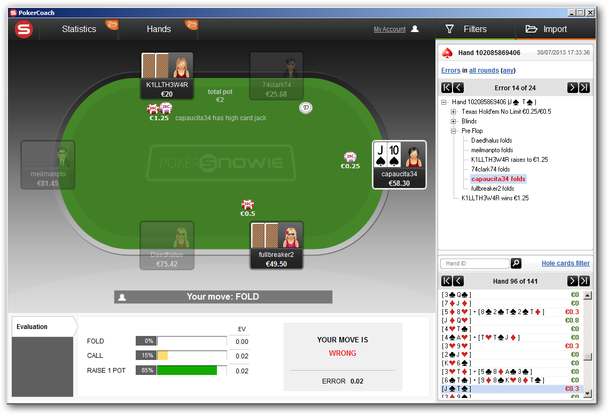- Snowie Games, famed for its leading backgammon product, recently unveiled its first software product under the new PokerSnowie brand.
- The new Windows-download software package aims to teach Hold’em through analyzing your play.
- Its strategy is close to optimal, it is claimed, and is “arguably the best No Limit Hold’em poker player in the world.”
- Snowie’s bold claims could be easily dismissed if it weren’t for the company’s excellent credentials in building the industry standard for Backgammon analysis.
- The product is lacking in features that would accelerate the learning process.
Snowie Games, famed for its leading backgammon product, recently unveiled its first software product under the new PokerSnowie brand. Poker Coach promises to teach players “perfect” game-theoretical No Limit Hold’em using a proprietary neural network system that Snowie claims gives the best NL strategy advice in the world.
The new Windows-download software package aims to teach Hold’em through analyzing your play. It imports your hand histories (ten online poker rooms are supported) and analyzes every hand you play. Heads up, short-handed and full ring tables are supported, for NL cash games only. It can analyze short-stack situations as well as hands as deep as 400 big blinds. The software is for post-game study only; the program does not open when poker clients are running.
Once you have a poker session imported, Snowie quickly analyzes your play and gives you an overall grade. Using terminology common to backgammon and chess programs, it then highlights “blunders” and “errors,” based on the EV cost of deviating from what Snowie believes to be “perfect play.”
On what does Snowie base its expert analysis? According to the website, the engine was built from over three years of research and development, using a proprietary neural network that was exhaustively trained against other bots that attempted to exploit its strategy. No expert knowledge was used; the system was entirely trained through the machine learning process.
According to the website, PokerSnowie has achieved world class playing abilities. Its strategy is close to optimal, it is claimed, and is “arguably the best No Limit Hold’em poker player in the world.”
The Interface
The interface is simple. You can step through each mistake, and the system will show you its recommendation. Commonly it recommends a mixed strategy—where it recommends picking one of two different actions at a specific frequency, randomizing your play—which it presents in simple action bars.
Here, Snowie recommends 3-betting 85% of the time, and flat-calling 15% of the time—and never folding, like my nitty self did. However, it also estimates that this mixed strategy nets only +0.02 blinds in EV (compared with 0 for a fold, of course), so this mistake is classed as just a minor error, rather than a bigger “blunder” enfraction.
Of course, software designed in this way will explain the what, but it won’t explain the why—the Snowie algorithm knows nothing about reasons behind its decision; only that its strategy is the least exploitable. This could make it hard to internalize its recommendations and learn from mistakes.
What is perhaps most lacking is a way to interrogate and construct your own scenarios. It is one thing to see that the three-bet with JTs here in the small blind being more profitable, but there’s no way to test other scenarios. What’s the lowest hand in my range I should 3 bet? What if I manipulate the stack sizes? Or put myself on the button?
I am already imagining myself creating “fake” hand histories that vary one variable—trying all types of hole cards, or different stack sizes, or changing hero’s position—then importing them all so I can learn about a specific scenario. It is unfortunate that this is not possible in the software itself.
There is also no active training option, like allowing you to play against other opponents, or any form of quiz to let you test your knowledge. I get the impression these restrictions are conscious designs by the software developers; Snowie Games is already planning a preflop advisor and poker trainer as separate packages that fill some of these feature gaps.
There is another significant restriction, and that is bet sizes. Snowie’s algorithm was designed to only choose between three bet sizes—half pot, pot, and twice pot. This is a known limitation, and the developer regrets not training the software with a 0.75 pot bet size. This is something they plan to implement, although the training process takes a very long time so it might be a while before this is added.
Cost and Conclusions
For a single-feature tool, Poker Coach does not come cheap. All the calculations are done “in the cloud,” and the service is charged as a monthly recurring fee using a credits-based system. Credits are spent to analyze a hand, with 1 credit used for low stakes hands up to 4 credits for hands above NL200. The cheapest option still runs at €39 a month and allows for 20,000 low stakes hands to be analyzed; the biggest package is €159 a month and there are still limits in place.
For annual subscriptions, the prices do go down, but still this will be cost prohibitive to many, but for serious professional players it is a small cost if it really does provide an edge to learning. Snowie’s bold claims could be easily dismissed if it weren’t for the company’s excellent credentials in building the industry standard for Backgammon analysis. The website takes pains to point out both its strengths and weaknesses, and explains well the differences between GTO and exploitative poker play.
The interface is simple and easy to use, and the software does what it says. It feels purposefully restrictive in places, and ways to customize the hands so you can see the answers for similar scenarios would be a big improvement, especially for the cost.
But ultimately, it all comes down to how good the advice is. I tested the program out under a free trial, and its recommendations seemed sane (which surprised me somewhat, as GTO play is often unintuitive); but i am certainly no NL game theory expert. What would be good is to see is it compete in open competitions to see if its claims hold up under independent testing.
It is not cheap, but if the product is as good as it says it is, then it is still an easy purchase for serious NL players. Those interested can start a free trial, which gives you ten days and 2000 credits to play with. That should be enough time to get a feel for its advice, and whether it would provide value to your game.




